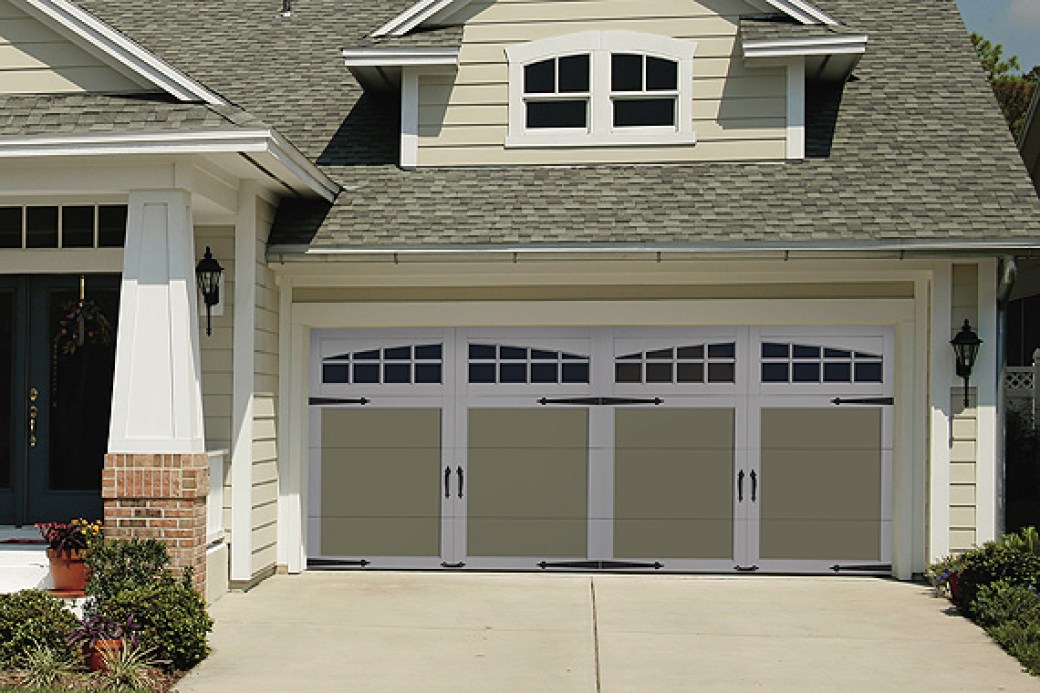With good looks, modest cost, and solid return on your investment, a new garage door is the Triple Crown of curb appeal projects. According to the "Remodeling Impact Report" from the NATIONAL ASSOCIATION OF REALTORS®, the national median cost of a garage door replacement project is $2,000 and recovers 100% of your investment if you sell your house.
Add the fact that a front-facing garage door can eat up almost 20% of your home's front facade. With that much curb appeal at stake, a worn-out, beat-up garage door can be a real liability. No wonder a big majority of homeowners responding to the report gave a garage door replacement project a joy score of 9.0 -- a rating based on those who said they were happy or satisfied with their remodeling, with 10 being the highest rating and one the lowest.
"Especially on houses where the garage is front and center, the garage door absolutely has to look good," says Casey McGrath, a real estate practitioner in Kitsap County, Wash. And it has to operate smoothly: Americans use the garage more than any other entry to the house, including the front door, according to a survey commissioned by window and door manufacturer JELD-WEN.
Types of Garage Doors
Garage doors come in four basic types: They may swing out, swing up, roll up, or slide to the side.
Swing-out carriage-house doors or sliding barn doors are a good choice if you need to keep the ceiling clear or if you want their distinctive look. Otherwise, the most popular option by far is the sectional roll-up door.
Before purchasing a roll-up door, measure the space between the top of the garage door opening and the ceiling or overhead framing. Standard tracks require headroom of about 14 inches. If you don't have that, you can get low-headroom track, which costs about $100 more. There are also tracks specially made for garages with unusually high walls or cathedral ceilings.
Choosing the Right Style
It's important to pick a door that suits the style of your house. If you live in a Craftsman bungalow, for example, you might want something that looks like the swing-out doors found on garages behind early Craftsman houses. Manufacturers of modern roll-up doors make them in styles that mimic the old swing doors, complete with faux strap hinges on the sides and a pair of handles flanking a deep groove in the center.
Most styles, whether traditional or contemporary, feature panels, trim, and other detailing. Doors with true frame-and-panel construction tend to be sturdier than those with decorative detail that is merely glued or nailed on. Many styles have glass panels on the top row, which looks inviting from the street and brings daylight inside. You can also find roll-up doors with shatterproof glass or frosted plastic in all the panels, for a more modern look.
Common Garage Door Materials
Wood: Wood offers a charm and authenticity that other materials merely mimic. Wood doors can be made locally in whatever size you need, and they stand up well to bumps from basketballs. The downside is that they require frequent repainting or refinishing, especially if you live in a damp climate.
Wood doors range from midprice to very expensive, depending on whether they consist of a lightweight wooden frame filled with foam insulation and wrapped in a plywood or hardboard skin (the least expensive) or are true frame-and-panel doors made of durable mahogany, redwood, or cedar. Wood doors usually carry a short warranty, perhaps only one year.
Steel: Metal is a better choice than wood if you don't want a lot of maintenance. Steel leads the pack because it is relatively inexpensive yet tough. Bare steel rusts, so you need to touch up scratches promptly, and steel also dents.
Minimize this risk by choosing doors with sturdy 24- or 25-gauge panels rather than 27- or 28-gauge (the higher the gauge number, the thinner the metal). Or consider a steel door with a fiberglass overlay, which resists dents and doesn't rust. Fiberglass will need periodic repainting or restaining, though, because the color fades over time.
High-quality steel doors may have lifetime warranties on the hardware, laminations between the steel and any insulation, and factory-applied paint. Budget doors tend to have shorter warranties on some components, such as paint and springs.
Aluminum: Inexpensive aluminum doors, once common, have largely been replaced by sturdy versions with heavy-duty extruded frames and dent-resistant laminated panels. Rugged and rust-proof, these are a wonderful choice -- if you can spend $10,000 or so on a garage door.
Less expensive aluminum doors have aluminum frames and panels made of other materials, such as high-density polyethylene. Because of its light weight, aluminum is a good choice if you have an extra-wide double door; it won't put as much strain on the operating mechanism.
Insulation and Energy Savings
Considering the size of a garage door, it might seem obvious that you should invest in one that's insulated. Because of its sandwich construction, an insulated door is more durable, and the enclosed back panel gives a garage interior a more finished look.
But the insulation won't save energy unless you heat the garage or treat your attached garage as part of the "conditioned" part of your house. The federal Energy Star program recommends against doing this if you park cars, store lawn chemicals, or use solvents there because it could let dangerous fumes inside; it's better to insulate only the shared wall and use that as the indoor-outdoor boundary.
Related:
